AKC Educators
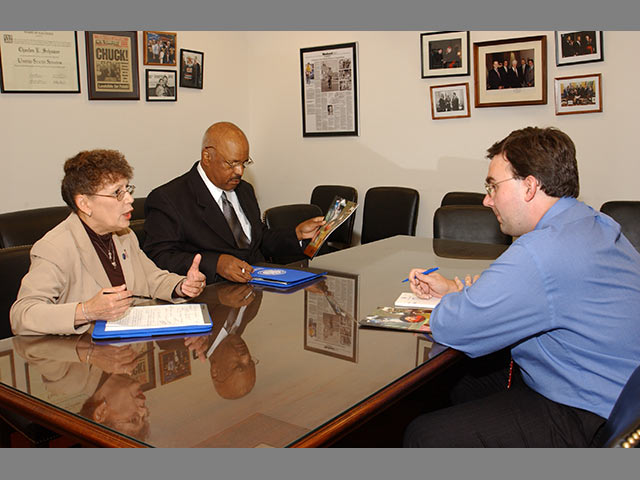
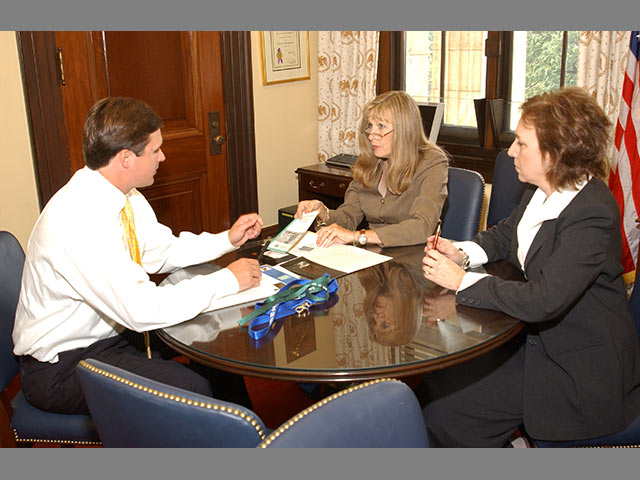

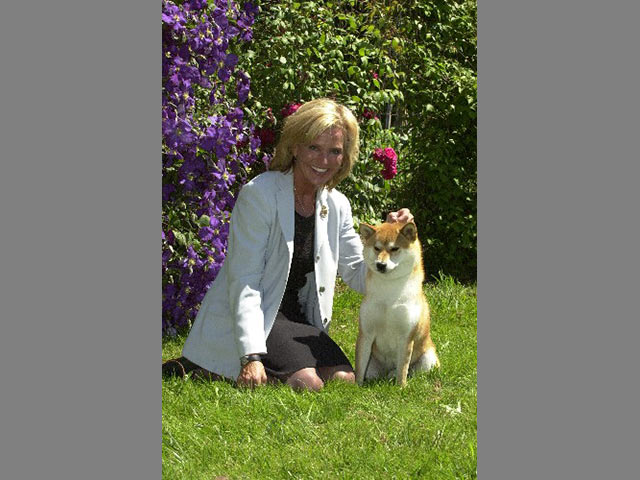
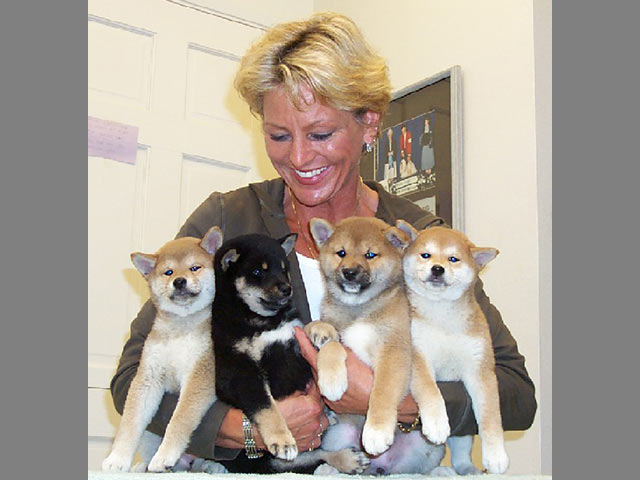
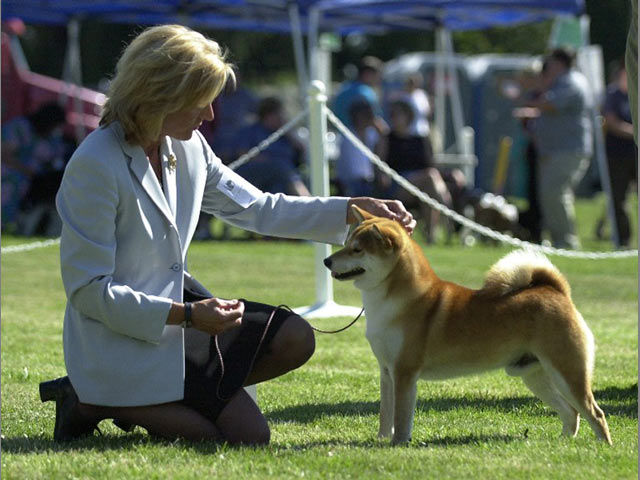
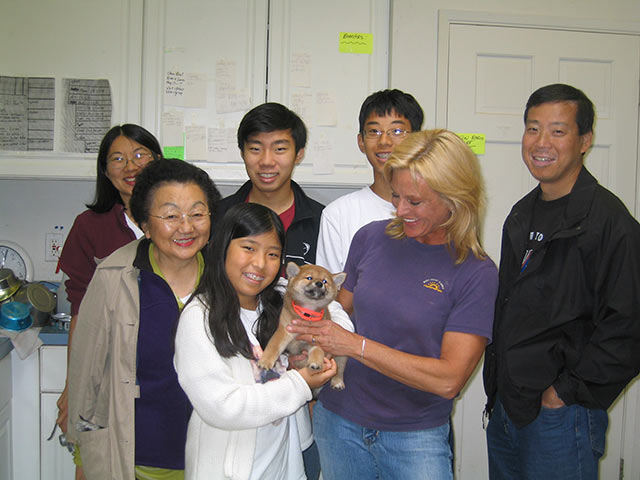
So You Want a Dog?
"I've got the best job. I attend dog shows and talk to people about dogs. It doesn't get any better than that."
Those are the words of Larry Sorenson, who directs the AKC's Public Education Department, which creates and distributes information to schools, libraries, and dog clubs, mainly through an education booth that travels with dog shows around the country. In the booth, Mr. Sorenson and his staff field a range of questions, face-to-face, from as many as 2,200 people in a single day. Barbara Ohmann, who directs Club Educational Services at AKC and also works in the booth, combines her degree in elementary education and her experience as a breeder of Labrador Retrievers. "I have a natural tendency towards teaching, and I help people make dogs part of their family, part of society." Varying their approach to match a client's knowledge, Ms. Ohmann and Mr. Sorenson give information that is remembered long after the show.
For regulars, the dog show atmosphere is cozy. But for people just starting out, it can be intimidating, so Mr. Sorenson and Ms. Ohmann need to warm their clients up. "At first, people don't know what to ask. It may take 15 minutes before you have a productive conversation," Mr. Sorenson says. During that time, he observes clues, reads between the lines. "They are there on their own free will," Mr. Sorenson explains. "They know owning a dog is a serious commitment, that they're bringing a life into their house. I move the conversation in that direction. When they see you're friendly, they're no longer reserved."
Once the questions roll, challenges set in. Family members may have their hearts set on a particular breed, but considering their lifestyle the choice may not be optimal. Other times, the choice makes sense, but they need to learn what to expect. In either case, the education staff reaches into a collection of charts, books, and other materials to explain what that choice means. Using laptops with Internet connection in the booth, Ms. Ohmann and Mr. Sorenson call up screenfulls of information and print them for the client. For live back-up, there is the vast team of specialists bustling around them. "We send them over to the ring showing the dog they want," Ms. Ohmann explains. "They meet and speak with people who really know the dogs."
The education staff are always aware that their handling can create, or hold back, long-term interest. "How we treat them makes a big difference," Mr. Sorenson says. "You don't want to turn people off by lecturing them." Ms. Ohmann sees her access to people as a privilege. "We meet lots of children with simple questions. A few years later, they're showing at Westminster. Then they become professional handlers." It could all start with an interaction at the booth.
Guiding people through all the breed choices is hard enough. The latest designer breeds, such as Labradoodles, make extra work. Even though she has serious doubts, Ms. Ohmann says it is never wise to tell a client not to get one. "You listen to what they're saying. They want great health, great personality? Well, the Labrador has wonderful traits. The Poodle has wonderful traits. But the Labradoodle doesn't have predictability." After gently prodding, if the client is still not convinced, Ms. Ohmann may ask them, "Does the breeder offer you health and coat guarantees? Is it in writing?"
The final step is to talk about reputable breeders. "I tell them about AKC certification," Mr. Sorenson says, "how to make sure papers are valid and in order." Then, with the words of the education staff buzzing in the clients' minds, brochures and printed information in the clients' hands, the education staff has done their part. They offer to stay in touch, and hope their messages got through.
Education does not stop at the show. Leslie Ann Engen, who breeds Shiba Inus from her home in the Redmond, Washington, area, makes positive use of the fact that prospective owners look up to her and want to gain her respect. "Breeders often underestimate their ability to provide direction," she says. "Devoting some time, you can take people under your wing. You can give them everything they need to make the right choice and develop deep interest in the breed." Ms. Engen says she never dictates rights and wrongs. Instead, "I tell them what works for my breed, what I do, and how I know they are responsible people and of course they want to do what's right."
Ms. Engen has some steadfast rules. "I never allow someone to just go home with a puppy. When they see the puppies, they are on a high. They need to weigh everything." In fact, she insists that families come back to see her several times. During those repeated visits, Ms. Engen creates a complete portrait of her breed, positives and challenges. "I require spay or neuter, and I offer a rebate on obedience training. This develops a great regimen. I'm making sure they won't have an adult dog with bad habits, and the owner starts right off on a responsible level." The benefits of early responsibility, Ms. Engen says, extend far into the future. "So many people start in basic obedience, get hooked on agility, then move onto advanced classes. Before long, they're telling others about doing it."
One of Ms. Engen's favorite steps is to have prospective owners take photos of her Shiba Inus. "This includes simple shots of the puppies with the mother, rudimentary things that make people appreciate the time and effort that went into the puppy." Ms. Engen creates an album and presents it to the owners. More than just a memento, this has practical value. "The family will see a general exam of the mouth and ears, how to get the puppy to sit and stay, a lot of things the breeder does that buyers usually don't know about. By the time they take the puppy home, they're hooked. That's a family member."
Starting Early, Engaging Children
"I lived my whole childhood terrified of dogs."
That is from Anne Lettis, a supreme dog lover and breeder of Boxers and Staffordshire Terriers, who has been going into New York City schools for over 20 years to teach kids about dogs. "When I was a child, I missed out. It was a terrible loss. So now I feel it is important to tell kids about being safe around dogs, how to enjoy dogs."
In the early 1980s, Ms. Lettis began visiting schools with the New Jersey Dog Owners Education League. "We were mostly doing demonstrations. The kids would watch dogs do tricks. But I wanted to do more. I wanted kids to go home with knowledge." She then became director of the Responsible Dog Owners Association of New York and developed her own routine, which she has so far taken into 15 schools.
Before a gymnasium full of kids, it is just Ann and Will, her Boxer. "I always start off asking, 'Who's afraid of dogs?' Inevitably, a child raises her hand. Maybe the other kids laugh a bit. I tell them that everyone is afraid of something, maybe the dark, flying, maybe scary movies.'" That gets the kids giggling about all the things people are afraid of. "I say that I'm not there to tell them not to be afraid. I just want to offer some tips, what to do if they see a dog." Turning to Will, Ms. Lettis demonstrates some of the proper ways to approach and greet a dog. "Then I tell them, 'You know what? When I was a kid, if I saw a dog I would hyperventilate!'" She laughs and tells them, "I would try to climb a telephone poll to get away from a dog that was two blocks away." Now the kids are laughing with her. While holding the kids' attention, she and Will demonstrate all the right steps.
Some of Ms. Lettis' most memorable work is in special-education settings. She tells the story of how she and Will helped Jason, an autistic boy with such a tremendous fear of dogs his parents were concerned for his safety. "His mother could never understand why he was so afraid, but he'd just panic." When she first came to the school, Jason refused to be anywhere near Will. "He went into another room and wouldn't come out." In the distance, Ms. Lettis could see Jason peering through the door, so she gathered the other kids around to play with will in line with Jason's sight.
"Little by little, Jason got more curious. Then one day, he stood outside the door and watched. The next day, I brought in a spray bottle, because Will loves to drink from it." Jason edged closer, and one day Ms. Lettis handed him the spray bottle and asked if he wanted to give Will some water. "Jason did it. I have photographs of this," Ms. Lettis says, "It was amazing. In a few more days, Jason took Will by the leash and walked with him outside. His mother wrote to me and said all this was really helping."
"When you do your talks, and then leave," Ms. Lettis says, "you don't know if it succeeded." But sometimes she gets some proof. While out walking one day, a little girl approached and asked to pet Will. Ms. Lettis said, "Wow, that's terrific, you really know how to greet a dog. The girl said, 'I remember you from assembly last year.' If you use humor and analogies they can relate to, they have fun and want to learn. And they remember you."
Being a Good Citizen
"Good behavior is 25% about the dogs, and 75% about humans."
This is how Dr. Mary Burch, director of the Canine Good Citizen Program at the AKC, sees responsibility. Since 1994, she has overseen classes and evaluations administered throughout the country on good behavior. Dr. Burch holds a Ph.D. in psychology, with a focus on education, and did consulting for schools before joining the AKC. She says her academic background and love of dogs combine nicely in her Canine Good Citizen efforts. "We teach manners, on both end of the leash," Dr. Burch says, offering a scene that epitomizes her work: "I'm in the park. Someone's dog comes running up to me, off leash. The owner is way over there shouting, 'He's friendly!' I love dogs, but we don't have the right to disturb anyone else's walk."
Since the Canine Good Citizen Program began in 1989, over 500,000 dogs have been certified, with 30,000 enrolling each new year. The classes—one hour a week over a six- to eight-week period—are sponsored at the local level by the nation's 5,000 local dog clubs. From the Canine Good Citizen headquarters in Raleigh, North Carolina, Dr. Burch says, "We develop the materials and basic framework. Clubs develop specifics." The trainers must be flexible, with leeway to emphasize local ordinances, vary their methods for urban and rural settings, and individualize their instruction to match students' initial good citizenship levels.
Although methods vary, Dr. Burch sets strict expectations of what dogs must do to earn certification. There are 10 markers of good citizenship, evaluated in a test at the end of the class. Some are basics like sit, come, stay, and lie down. But there are refinements, such as meeting a friendly stranger, where "a person comes up to you and shakes your hand with the dog at your side," Dr. Burch explains. There is tolerance of petting, in which "a person just walks up and pets your dog." Getting more up close and personal, there is touching of ears and front feet: "dogs that are not socialized often snap or growl if you do this." Next is what Dr. Burch describes as "the-arm-cannot-come-out-of-the-socket test," where the dog goes for a walk on a loose leash, makes a pattern, and returns to the starting position. Dogs must pass the distraction test, in which "two people approach with dogs on either side, shake hands with the owner, then keep going without your dog jumping on the other ones." Finally, a test of supervised separation, where "someone holds your dog while you go out of sight for a while." Students practice these skill outside the class for at least 15 minutes a day. "You need to do the exercises in real-world settings," Dr. Burch emphasizes. "The dog walks on a leash in the gym, but what about on a busy sidewalk?"
Excellent results have given the Canine Good Citizen Program growing respect. Several insurance companies charge extra on their homeowner policies for certain breeds, or refuse to insure others. But with Canine Good Citizen certification, some insurance companies waive the added fee or accept dogs they normally will not cover. Therapy International, which trains dogs for a range of service jobs, now seeks out dogs with Canine Good Citizenship certification as part of their screening.
On public trails in Boulder, Colorado, tension was brewing over incidents of bad behavior, and town officials were poised to ban dogs. Then the people of Boulder reached a compromise. Hearing about the Canine Good Citizen Program, they agreed that only dogs with certification could walk on the trails. The effort has been a success, improving relations. It has become a symbol of pride to display the collar tag proclaiming that human and dog have both learned to be good citizens.
The Meaning of Education
Leslie Ann Engen's thoughts about the future of her breed have universal appeal. "People who buy my dogs today are tomorrow's show people. We need to have high expectations of them, whether they just want a pet or have bigger plans. Each of us has our own personality, our own way of doing things, but all of us has the potential to make a difference."
Sometimes, the human has more at stake than the dog. Mary Burch tells the story of a troubled 13-year-old girl. "She was beating kids up, getting kicked out of schools, getting suspended." Then the girl got involved in the Canine Good Citizen Program, training Saint Bernards. Those classes, where good behavior and thinking of others was a constant focus, had an impact. "Her own behavior improved dramatically," Dr. Burch says. "She wrote to me, saying it changed her life. She learned how to be a good citizen."
